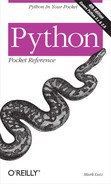Command lines are used to launch Python programs from a system shell prompt. Command-line options intended for Python itself appear before the specification of the program code to be run. Options intended for the code to be run appear after the program specification. Command lines have the following format:
python [option*] [scriptfilename| -ccommand| -mmodule| - ] [arg*]
-bIssues warnings for calling
str()with abytesorbytearrayobject, and comparing abytesorbytearraywith astr. Option-bbissues errors instead.-B-dTurns on parser debugging output (for developers of the Python core).
-EIgnores Python environment variables described ahead (such as
PYTHONPATH).-hPrints help message and exit.
-iEnters interactive mode after executing a script. Useful for postmortem debugging.
-OOptimizes generated byte-code (create and use .pyo byte-code files). Currently yields a minor performance improvement.
-OOOperates like
-O, the previous option, but also removes docstrings from byte-code.-sDo not add the user site directory to the
sys.pathmodule search path.-S-u-vPrints a message each time a module is initialized, showing the place from which it is loaded; repeats this flag for more verbose output.
-V-WargFunctions as warning control;
argtakes the formaction:message:category:module:lineno. Seewarningsmodule documentation in the Python Library Reference manual (available at http://www.python.org/doc/).-xSkips first line of source, allowing use of non-Unix forms of
#!cmd.
scriptfilenameDenotes the name of a Python scriptfile to execute as the main, topmost file of a program execute (e.g.,
python main.py). The script’s name is made available insys.argv[0].-ccommandSpecifies a Python command (as a string) to execute (e.g.,
python -c "print('spam' * 8)"runs a print call).sys.argv[0]is set to-c.-mmoduleRuns library module as a script: searches for module on
sys.path, and runs it as a top-level file (e.g.,python -m profileruns the Python profiler located in a standard library directory).sys.argv[0]is set to the module’s full path name.−Reads Python commands from stdin (the default); enters interactive mode if stdin is a tty (interactive device).
sys.argv[0]is set to−.arg*Indicates that anything else on the command line is passed to the scriptfile or command (and appears in the built-in list of strings
sys.argv[1:]).
If no scriptfilename,
command, or
module is given, Python enters interactive
mode, reading commands from stdin
(and using GNU readline, if installed, for input).
Besides using traditional command lines at a system shell prompt, you can also generally start Python programs by clicking their filenames in a file explorer GUI, by calling functions in the Python/C API, by using program launch menu options in IDEs such as IDLE, Komodo, Eclipse, NetBeans, and so on.
Note
Python 2.6 does not support the -b option, which is related to Python
3.0’s string type changes. It supports additional options:
-tissues warnings for inconsistent mixtures of tabs and spaces in indentation (-ttissues errors instead). Python 3.0 always treats such mixtures as syntax errors.-Qdivision-related options:-Qold(the default), -Qwarn,-Qwarnall, and–Qnew. These are subsumed by the new true division behavior of Python 3.0.−3issues warnings about any Python 3.X incompatibilities in code.
